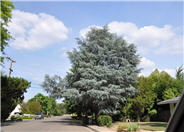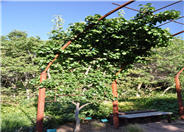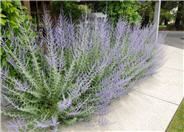
Common name:Blue Atlas Cedar
Botanical name:Cedrus atlantica 'Glauca'
As a large, slow-growing conifer, Blue Atlas Cedar requires ample room for growth. It has a broad, pyramidal form and is an eye-catching specimen for a large landscape. It's needles are 1 inch long, and are a beautiful shade of silvery blue. In order to develop its best color, the tree needs to be exposed to full sun. It can reach up to 40 to 60 feet tall and up to 30 feet wide. There is also a weeping form, Cedrus atlantica 'Glauca Pendula.' Cedars have lovely cones, emerging bluish when young and aging a reddish brown.

Common name:Flowering Pear
Botanical name:Pyrus calleryana
This is the species of pear known as Flowering Pear, a highly ornamental, nearly ubiquitous deciduous tree favored by contractors, landscape designers, and homeowners. Many cultivars are avaialble in the trade, though they all possess some shared qualities: white spring flower that emerge before the foliage; glossy green foliage that turns red in fall; non-fruiting to small insignificant fruit; and a tolerance for urban conditions.

Common name:Russian Sage
Botanical name:Perovskia atriplicifolia
Russian sage may be the ubiquitous low-water garden plant. With its grey green, aromatic foliage, and azure blue spires, it provides a long-lasting show in hot, dry gardens. It grows to 3 to 5 feet tall, and nearly as wide. It is a woody perennial and forms a very hard trunk over time. It is both airy and substantial, and partners well with herbaceous perennials, woody shrubs, or ornamental grasses. It also would grow well against a south or west facing wall or fence.
| Designer: Xeriscape Design | Aja Architects 5 |
Photographer: GardenSoft |
Water Saving Tip:
Even though it's hot, your lawn only needs to be watered twice a week to stay healthy.
And don't water the whole lawn for a brown spot—drag out a hose.
